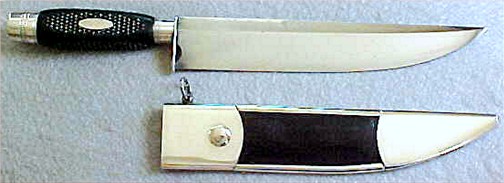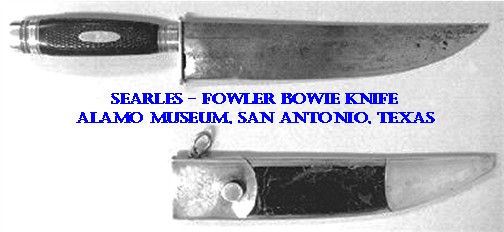|
MAGNIFICENT SILVER MOUNTED BOWIE KNIFE – AN
EXACTING RECREATION OF THE FAMOUS SEARLES-BOWIE-FOWLER
KNIFE NOW ON DISPLAY AT THE ALAMO MUSEUM: This
is an exacting recreation of the famous Searles – Fowler
knife which was made by Daniel Searles and presented by
Rezin Pleasant Bowie to Captain Henry Waller Fowler, 2ND
Regiment of Dragoons, US Army.

Rendered by the well known master miniature-firearms
maker, Dan Osterman of Junction City, Oregon, this
faithful recreation of one of the most famous extant
Bowie knives transcends the scope of a historic edged
weapon and presents as a fine example of the classic
knife maker’s art.
The original “Searles-Fowler” knife – as it is known
within the Bowie knife collecting community – is
considered to be one of the finest examples of an early
Bowie in existence and it is currently held in the
collection of the Alamo Museum, San Antonio, Texas. The
silver throat of the scabbard bears the engraved
inscription: "R. P. Bowie to H. W. Fowler, U. S. D."

Born in Maryland in 1782, Daniel Searles served in the
militia under Andrew Jackson at New Orleans, attaining
the rank of captain. Remaining in Louisiana after the
end of hostilities, by the 1820’s he had settled his
family in Baton Rouge. In March of 1826 he purchased a
lot on St. Louis Street for his home and gunsmith shop,
and in 1836 having purchased two additional lots on St.
Phillips Street which backed on to the first property,
he built a new home and gunsmith shop.
It is believed that the new shop was where Searles made
the knives commissioned by Rezin Bowie – perhaps as many
as four that are known - which were presented by Rezin
to: Louisiana Governor E. D. White (still in possession
of the family), Edwin Forrest, a prominent
nineteenth-century American Shakespearean actor (the
veracity of this claim has been questioned), a Mr.
Stafford of Alexandria, La. (still owned by his
descendants), and the Henry Fowler knife.
It has been suggested that in the absence of any knife
that can be documented as having personally belonged to
James Bowie, the Searles knives made for Rezin may be
the most historically relevant Bowies in existence.
While not exact replicas of the original “Sandbar
Knife”, the Searles knives do conform very closely to
Rezin's description when he wrote, "The length of the
knife was nine and one-quarter inches, its width one and
a half inches, single edge and blade not curved. . . ."
The blade on the Fowler
knife is nine and one quarter inches long, and the blade
on the Stafford Bowie is only slightly longer. Both
knives feature single-edged straight-back blades rather
than the curved clip-points that were later associated
with the Bowie knife design.
There are other distinctive similarities shared by at
least two of the Searles knives made for Rezin: a silver
escutcheon plate inlaid into the right side of the
handle, the half-moon cut out of the lower rear of the
blade immediately in front of the guard, and elegant
scabbards of black leather mounted with coin silver
throats and tips connected by silver ribs extending
along the edges of the sheaths.
In the age of the Bowie
knife, the Searles knives were expensive status symbols
which only the wealthy could afford. The excellent
condition of all the Searles knives in existence today
suggests they were worn as a deadly adornment by their
socially prominent owners as they strolled the town
bedecked in top hats, frock coats and ruffled silk
shirts, rather than subjected to utilitarian chores on
the frontier. To paraphrase Noah Smithwick (an early
Texas blacksmith and friend of James Bowie) - these
knives were not to be degraded by ordinary use.
While no record of the reasons for the presentations of
these knives is known to survive, the quality of the
gift and the social standing of the recipients indicate
these were men who were either in a position to assist
Rezin in some way, or they were held in high regard by
Resin – or perhaps both.
Born in 1800 in New York, Henry Waller Fowler was a
professional soldier with a long and distinguished
military career. In his early twenties, he joined the
marines, serving as a lieutenant for twelve years. In
1836, at the onset of the Seminole Wars, Fowler resigned
his commission in the Marines and that very day enlisted
in the US Army 2ND Regiment of Dragoons where
he was appointed to the rank of Captain. Serving in the
hostile environment of the Florida swamps, Fowler became
a casualty as his health deteriorated to the point that
he was forced to return to his home in Louisiana and
reluctantly he resigned his commission in 1841.
Given the inscription on the Fowler knife, the
presentation must have occurred during the Captain’s
five years of service with the 2ND Dragoons –
certainly no earlier, and no later as Rezin Bowie passed
away on January 17, 1841, shortly after Fowler’s return
from Florida.
In spite of his infirmities, Fowler did not shrink from
public service, being elected Sheriff of Baton Rouge
Parish in March of 1841 and holding the office until
February of 1845. With the outbreak of the Mexican War
in 1846, Fowler raised a company of volunteers and led
them to the Rio Grande where they were incorporated into
the 3RD Louisiana Volunteers and Fowler was
promoted to the rank of major. Never fully recovered
from the Florida campaign, his declining health again
caused him to return home to Baton Rouge for the last
time where he died on June 26, 1848.
Not all of Searles knives were made for Rezin, and at
least two knives believed to have been made by Searles
after Rezin’s passing incorporate the same style of
ebony grip, square in the cross section with each side
having the oval checkered panel highlighted with silver
pins, and the half-moon cut out from the ricasso of the
blade.
In March of 1860, Daniel Searles was alone – his wife
and son had passed away some seven years before – and
according to some accounts, he had soured on life. As
reported in the Baton Rouge Weekly Advocate,
“About four o'clock . . . Captain Searles requested to
be left alone, and when by himself he washed, shaved and
dressed, lay down on his bed, crossed his left hand over
his breast, took a pistol in his right and placing it
below the ear, pulled the trigger, and launched his sole
into eternity.” In a twist of irony, yet at the
same time not particularly surprising, the pistol was
one made by his own hand.
Dan Osterman was arguably one of the very finest
craftsmen of the 20th Century, well known for his
exquisite miniature historic firearms as well as a very
limited number of full-size historic Bowie knives.
Born on August 27, 1950 in San Jose, California, Dan
later moved to the Willamette Valley and from his shop
in Junction City, Oregon, he created a series of
jewel-like miniature firearms and high art knives that
have been featured in the book, THE ART OF MINIATURE
FIREARMS - CENTURIES OF CRAFTSMANSHIP by The
Miniature Arms Society (1999). Eleven separate pages
feature Osterman's masterpieces - cased and uncased,
engraved and plain, plated in gold or silver, and
gripped in ivory, mother of pearl and exotic woods.
Sometime around the year 2000, Dan began to intersperse
his miniature work with perfect recreations of known
historic Bowie knives and in the years 2000-2002 he
rendered this recreation of the Searles-Fowler knife.
Dan also crafted a miniature of the Searles-Fowler
knife which is featured on pages 294-295 in THE ART
OF MINIATURE FIREARMS.
This Osterman recreation includes all of the features
that are known to have been incorporated in the Searles
knives commissioned by Rezin Bowie. The knife measures
14 ¼” in overall length, and the blade is 9 ¼” long and
1 5/8” wide at the guard. The decorative half-moon cut
out of the blade immediately forward of the guard is a
distinctive feature found on two of the Searles knives
commissioned by Rezin Bowie. Adhering to the fashion of
the original Searles knives, there is a gold panel inlet
into the top flat of the blade bearing the maker’s
cartouche, “D.E. O.” punctuated with a small
cross. There is a hint of case color remaining from the
hardening process on the top flat of the blade between
the gold cartouche panel and the guard, a special
feature I find attractive as evidence of amount of labor
the maker committed to this knife. The balance of the
blade has a bright polish with no sharpening marks or
other faults.
All of the fittings on the knife are made of coin
silver, including the guard, grip ferrule and cap, and
the decorations on the grip. As with all of the known
Searles knives of that early period, the grip is made of
ebony, approximately square in the cross section with
rounded corners. An elongated silver oval is let into
each of the side panels. Each of the four sides of the
grip are embellished with an oval of high relief hand
cut checkering which is highlighted with the placement
of a fine silver pin in the center of each of the raised
diamonds.
The scabbard features a coin silver throat and tip
connected by silver ribs on both of the edges, framing a
panel of finely grained, gently aged black leather on
each side of the scabbard. The silver work is superbly
executed with no visible seams or joints to detract from
the appearance. The throat incorporates a hanging ring
and belt hanger stud – both features found on the
original Searles-Fowler scabbard. The finish of the
silver mountings on the scabbard is excellent and
without any flaws.
Included with the knife is an adjustable display stand
consisting of two nicely grained walnut supports and two
polished brass rods, which when assembled allow the
supports to be positioned so as to present the knife and
scabbard individually.
Years ago, I was fortunate to meet Dan, visit his shop –
a wonderful, “old world” setting that was as interesting
as the pieces he made – and view some of the miniature
arms that were in various stages of completion at the
time. Subsequently, Dan and I happened into one another
at a Houston Gun Collector’s show which was hosting the
Miniature Arms Society meeting in conjunction with the
show. During that weekend as we visited back and forth,
I had the opportunity to see firsthand the level of
respect and admiration collectors had for Dan’s work,
and the value they willingly afforded his miniature
arms. The limited number of full size Bowie knives Dan
produced is a relatively small part of his legacy, but
they are well recognized and highly prized by collectors
today. Dan suffered an unforeseen medical event in 2005
and his untimely passing resulted in not only the loss
of a master craftsman, but a true gentle man without
whom the world is a poorer place.
This recreation of the Searles-Fowler knife is a
masterpiece – a one of a kind piece of high art which
will never be duplicated. It combines the evocative
historical association of the original knife, with the
opportunity to own such an impressive Bowie - a singular
offering that will not be seen again.
SOLD
|

